
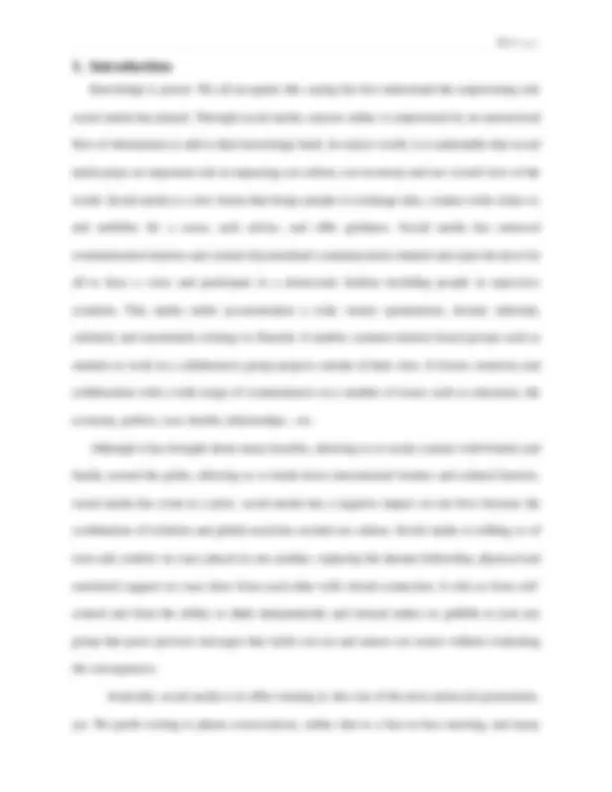
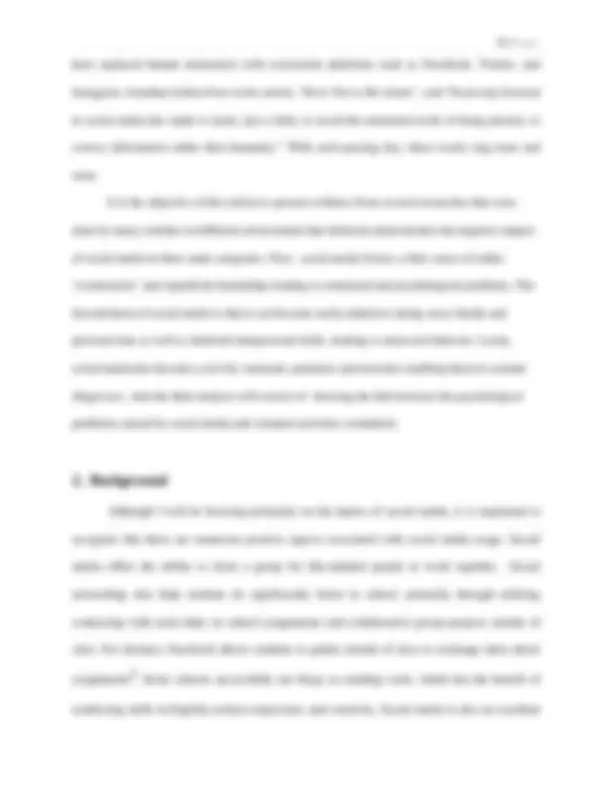
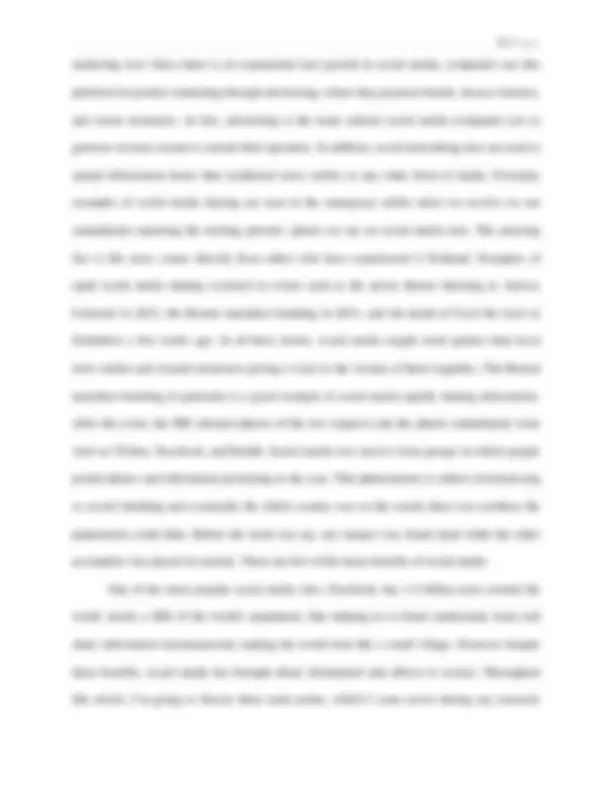
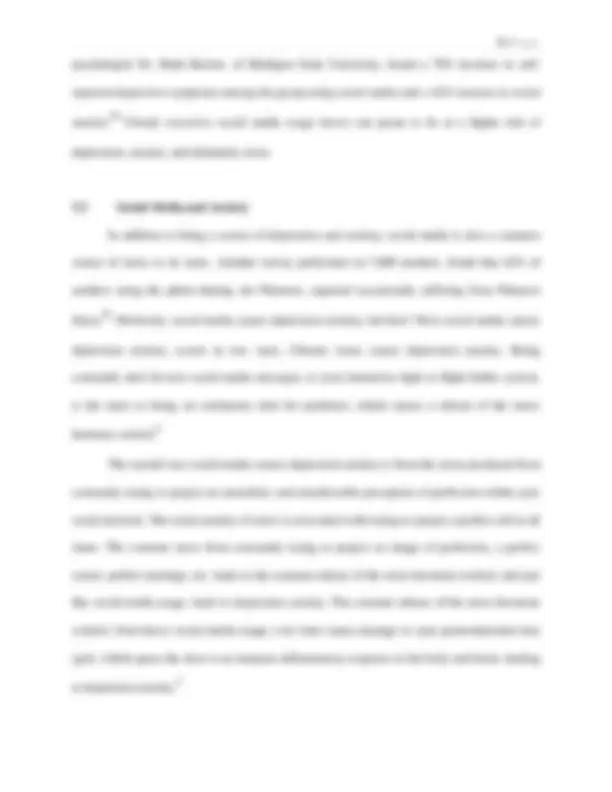
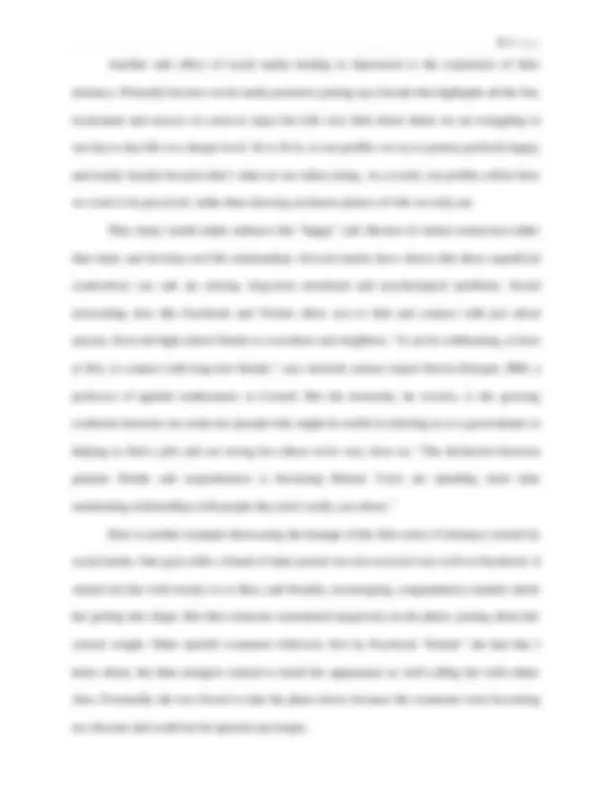
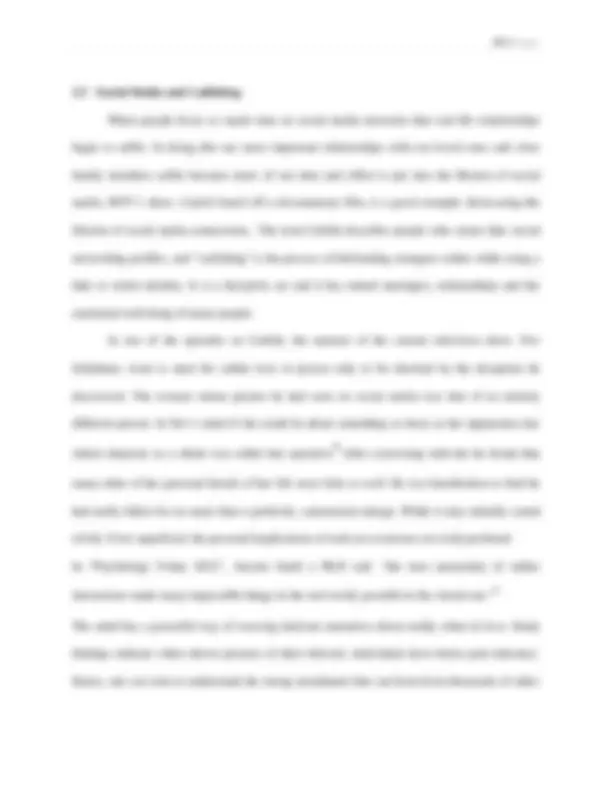
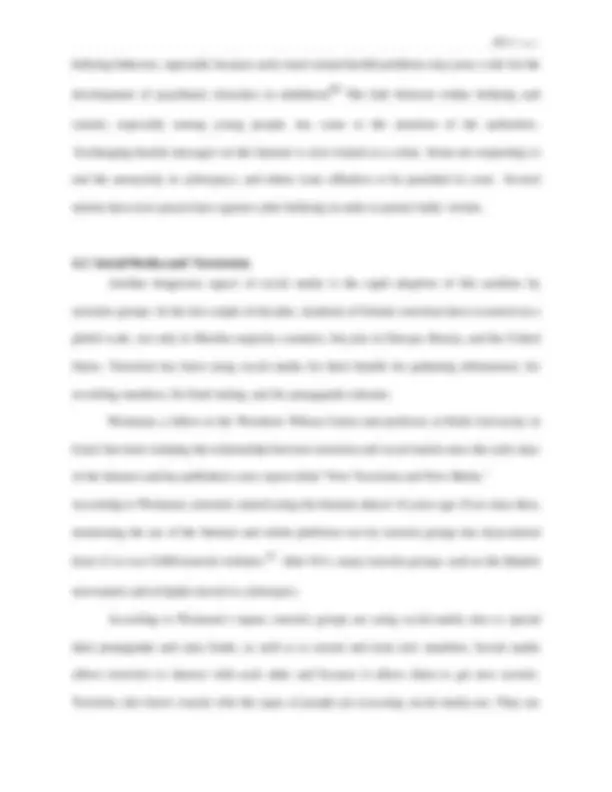
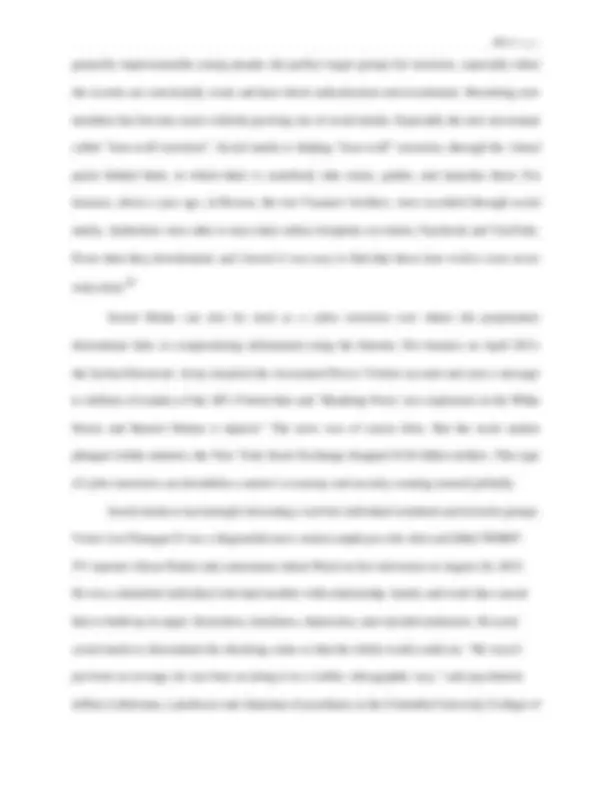
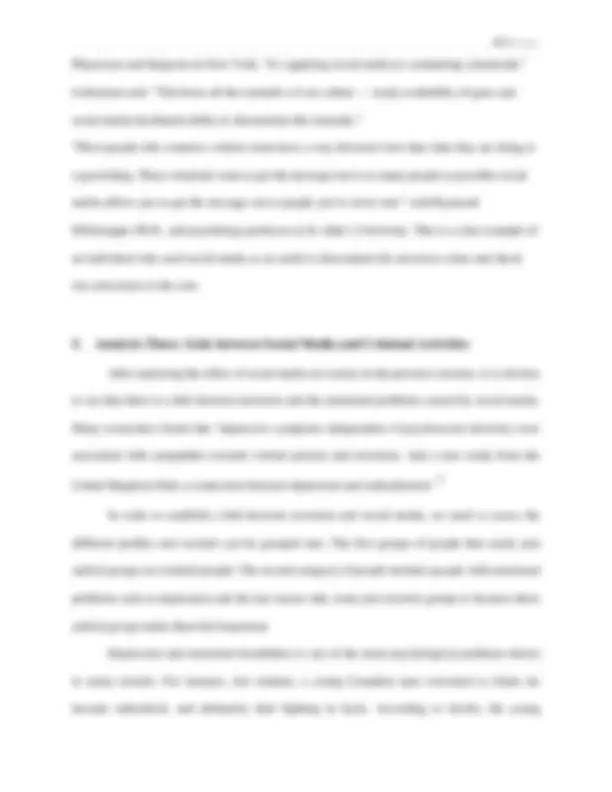

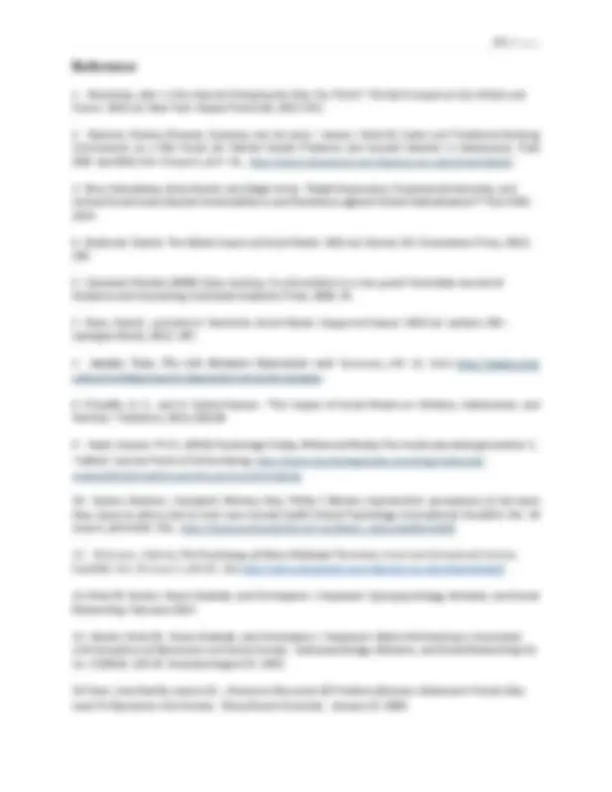


Study with the several resources on Docsity

Earn points by helping other students or get them with a premium plan


Prepare for your exams
Study with the several resources on Docsity

Earn points to download
Earn points by helping other students or get them with a premium plan
Community
Ask the community for help and clear up your study doubts
Discover the best universities in your country according to Docsity users
Free resources
Download our free guides on studying techniques, anxiety management strategies, and thesis advice from Docsity tutors
A research paper on Pop Culture Intersections
Typology: Essays (university)
1 / 19

This page cannot be seen from the preview
Don't miss anything!












September 2, 2015
Engl 176: Final Journal Paper Teacher: Professor Hendricks
have replaced human interaction with convenient platforms such as Facebook, Twitter, and Instagram. Jonathan Safran Foer in his article, “How Not to Be Alone”, said “Each step forward in social media has made it easier, just a little, to avoid the emotional work of being present, to convey information rather than humanity.” With each passing day, these words ring truer and truer. It is the objective of this article to present evidence from several researches that were done by many scholars in different environment that distinctly demonstrates the negative impact of social media in three main categories. First, social media fosters a false sense of online “connections” and superficial friendships leading to emotional and psychological problems. The Second harm of social media is that it can become easily addictive taking away family and personal time as well as diminish interpersonal skills, leading to antisocial behavior. Lastly, social media has become a tool for criminals, predators and terrorists enabling them to commit illegal acts. And the third analysis will consist of showing the link between the psychological problems caused by social media and criminal activities committed.
2. Background
Although I will be focusing primarily on the harms of social media, it is important to recognize that there are numerous positive aspects associated with social media usage. Social media offers the ability to form a group for like-minded people to work together. Social networking sites help students do significantly better in school, primarily through utilizing connecting with each other on school assignments and collaborative group projects outside of class. For instance, Facebook allows students to gather outside of class to exchange ideas about
assignments^5. Some schools successfully use blogs as teaching tools, which has the benefit of
reinforcing skills in English , written expression, and creativity. Social media is also an excellent
marketing tool. Since there is an exponential user growth in social media, companies use this platform for product marketing through advertising, where they promote brands, discuss features, and create awareness. In fact, advertising is the main scheme social media companies use to generate revenue stream to sustain their operation. In addition, social networking sites are used to spread information faster than traditional news outlets or any other form of media. Everyday examples of social media sharing are seen in the emergency amber alerts we receive on our smartphones reporting the missing persons’ photos we see on social media sites. The amazing fact is this news comes directly from others who have experienced it firsthand. Examples of rapid social media sharing occurred in events such as the movie theater shooting in Aurora, Colorado in 2012, the Boston marathon bombing in 2013, and the death of Cecil the Lion in Zimbabwe a few weeks ago. In all these stories, social media caught word quicker than local news outlets and created awareness giving a voice to the victims of these tragedies. The Boston marathon bombing in particular is a good example of social media rapidly sharing information. After the event, the FBI released photos of the two suspects and the photos immediately went viral on Twitter, Facebook, and Reddit. Social media was used to form groups in which people posted photos and information pertaining to the case. This phenomenon is called crowdsourcing or crowd sleuthing and eventually the whole country was on the watch; there was nowhere the perpetrators could hide. Before the week was up, one suspect was found dead while the other accomplice was placed in custody. These are few of the many benefits of social media. One of the most popular social media sites, Facebook, has 1.4 billion users around the world, nearly a fifth of the world's population, thus helping us to better understand, learn and share information instantaneously making the world look like a small village. However despite these benefits, social media has brought about detrimental side effects to society. Throughout this article, I’m going to discuss three main points, which I came across during my research:
One study proving the link between depression and social media, conducted by Professor Dr. Joanne Davila, her colleague, Lisa Starr, and Stony Brook University researchers discovered that, in a sample group of teenage girls, excessive Facebook usage caused the sample group to be at a higher risk for depression and anxiety. A year later, the researchers re-valuated the group for any signs of depression or anxiety. The study findings proved that users who frequently discussed their problems with friends, through social media, experienced higher levels of anxiety than those who did not. According to Dr. Davilla, "Texting, instant messaging and social networking make it very easy for adolescents to become even more anxious, which can lead to depression." Clearly social media is inadvertently leaving youth susceptible to become overly
self-conscious, anxious and ultimately depressed.^14
Social media is becoming the go to medium for these repeated discussions, allowing for the constant rehashing of the discussions over these girls’ “problems”, causing them to become obsessed over the “problem” and preventing them from moving on in life. For the most part, these “problems” are usually minor issue, such as being self-conscious of appearance; worrying about peer acceptance or wondering if a love is reciprocated. In the past, girls would write in journals or confide on the phone to their peers to deal with “problems”, in their lives. But now social media is now the primary channel for teens to vent current problems in their lives. Thus when a teen posts a problem online it is likely to receive both positive and negative comments, causing an obsession to develop on this “problem post”. Once something is shared online, it can never be taken back; even if the post is deleted it can still be found somewhere else on the web, or taken as a screenshot on another device, leading the sender to further into depression and anxiety. A new study has found that Individuals who engage in social media, gaming, texting, cell phones, etc., are more likely to have depression and anxiety. The study conducted by
psychologist Dr. Mark Becker, of Michigan State University, found a 70% increase in self- reported depressive symptoms among the group using social media and a 42% increase in social
anxiety.^13 Clearly excessive social media usage leaves one prone to be at a higher risk of
depression, anxiety, and ultimately stress.
3.2 Social Media and Anxiety In addition to being a source of depression and anxiety, social media is also a common source of stress to its users. Another survey performed on 7,000 mothers, found that 42% of mothers using the photo-sharing site Pinterest, reported occasionally suffering from Pinterest
Stress.^8 Obviously, social media causes depression anxiety, but how? How social media causes
depression anxiety, occurs in two ways. Chronic stress causes depression anxiety. Being constantly alert for new social media messages, to your instinctive fight or flight limbic system, is the same as being on continuous alert for predators, which causes a release of the stress hormone cortisol.^7
The second way social media causes depression anxiety is from the stress produced from constantly trying to project an unrealistic and unachievable perception of perfection within your social network. The social anxiety of stress is associated with trying to project a perfect self at all times. The constant stress from constantly trying to project an image of perfection, a perfect career, perfect marriage, etc. leads to the constant release of the stress hormone cortisol, and just like social media usage, leads to depression anxiety. The constant release of the stress hormone cortisol, from heavy social media usage, over time causes damage to your gastrointestinal tract (gut), which opens the door to an immuno-inflammatory response in the body and brain, leading to depression anxiety.^7
3.3 Social Media and Catfishing When people focus so much time on social media networks that real life relationships begin to suffer. In doing this our more important relationships with our loved ones and close family members suffer because more of our time and effort is put into the illusion of social media. MTV’s show, Catfish based off a documentary film, is a good example showcasing the illusion of social media connections. The term Catfish describes people who create fake social networking profiles, and "catfishing" is the process of befriending strangers online while using a fake or stolen identity. It is a deceptive act and it has ruined marriages, relationships and the emotional well being of many people. In one of the episodes on Catfish, the narrator of the current television show, Nev Schulman, went to meet his online love in person only to be shocked by the deception he discovered. The woman whose picture he had seen on social media was that of an entirely different person. In Nev’s mind if she could lie about something so basic as her appearance her
whole character as a whole was called into question.^9 After conversing with her he found that
many other of her personal details of her life were false as well. He was heartbroken to find he had really fallen for no more than a perfectly, constructed mirage. While it may initially sound trivial, if not superficial, the personal implications of such an occurrence are truly profound. In “Psychology Today 2012”, Auzeen Saedi a Ph.D said “the near anonymity of online interactions made many impossible things in the real world, possible in the virtual one.”^9
The mind has a powerful way of weaving intricate narratives about reality when in love. Study findings indicate when shown pictures of their beloved, individuals have better pain tolerance. Hence, one can start to understand the strong attachment that can form from thousands of miles
away through the exchange of repeated sentiments and promises of lifelong love with no more than a photo in hand. An additional insight of catfish, noted by Pauline Wiessner, PhD, a University of Utah anthropologist who studies social networks, says Anonymity also allows darker impulses to flourish. In one tragic case, 13-year-old Megan Meier hanged herself after being cyber bullied on Social media by Josh Evans—not a real boy, it turned out, but a false profile created by her adult neighbor. In the end many of us are looking for relationships, and believe we may find it in the most unlikely of places, such as social media, will leave us disappointed. Thus in this pursuit, staying vigilant and grounded in reality is paramount. The personal costs of excessive social media usage are high, leaving one open to anxiety, depression, stress and false connections. Due to the intensity of the online world, which requires constant engagement, users experience factor of self-awareness that usually triggers depression. In addition social media promotes the projection of a perfect self, which leads to depression anxiety. Social media promotes superficial connections that can end up causing long-term emotional and psychological problems. Social media also fosters false intimacy both intentionally false and unintentionally false, as seen in the selfie photo and catfish examples. Without acknowledging these negative personal impacts of social media, the harms, both psychological and emotional will continue to grow.
4. Analysis Two: Social Media and Criminal Activities
Besides the emotional problems described in the previous section, the second major idea covered in this article is the enabling of criminal activities through the use of social media. With the increased use of social media, malicious and irresponsible people benefit themselves of the freedom of social media platforms to lie, scam, attack, and hurt others in a number of ways.
bullying behavior, especially because early-onset mental health problems may pose a risk for the
development of psychiatric disorders in adulthood.^10 The link between online bullying and
suicide, especially among young people, has come to the attention of the authorities. Exchanging hostile messages on the Internet is now treated as a crime. Some are requesting to end the anonymity in cyberspace, and others want offenders to be punished in court. Several nations have now passed laws against cyber bullying in order to protect bully victims.
4.2 Social Media and Terrorism Another dangerous aspect of social media is the rapid adoption of this medium by terrorists groups. In the last couple of decades, incidents of Islamic terrorism have occurred on a global scale, not only in Muslim-majority countries, but also in Europe, Russia, and the United States. Terrorism has been using social media for their benefit for gathering information, for recruiting members, for fund raising, and for propaganda schemes. Weimann, a fellow at the Woodrow Wilson Center and professor at Haifa University in Israel, has been studying the relationship between terrorism and social media since the early days of the Internet and has published a new report titled "New Terrorism and New Media." According to Weimann, terrorists started using the Internet almost 16 years ago. Ever since then, monitoring the use of the Internet and online platforms use by terrorist groups has skyrocketed from 12 to over 9,800 terrorist websites.^11 After 9/11, many terrorist groups, such as the Jihadist
movements and al-Qaida moved to cyberspace. According to Weimann’s report, terrorist groups are using social-media sites to spread their propaganda and raise funds, as well as to recruit and train new members. Social media allows terrorists to interact with each other and because it allows them to get new recruits. Terrorists also know exactly who the types of people are accessing social media are. They are
generally impressionable young people; the perfect target groups for terrorists, especially when the recruits are emotionally weak and hear about radicalization and recruitment. Recruiting new members has become easier with the growing use of social media. Especially the new movement called "lone-wolf terrorism”. Social media is helping "lone-wolf" terrorism, through the virtual packs behind them, in which there is somebody who trains, guides, and launches them. For instance, about a year ago, in Boston, the two Tsarnaev brothers, were recruited through social media. Authorities were able to trace their online footprints on twitter, Facebook and YouTube. From what they downloaded, and viewed it was easy to find that those lone wolves were never truly alone.^11
Social Media can also be used as a cyber terrorism tool where the perpetrators disseminate false or compromising information using the Internet. For instance on April 2013, the Syrian Electronic Army attacked the Associated Press's Twitter account and sent a message to millions of readers of the AP's Twitter that said "Breaking News: two explosions in the White House and Barack Obama is injured." The news was of course false. But the stock market plunged within minutes; the New York Stock Exchange dropped $136 billion dollars. This type of cyber terrorism can destabilize a nation’s economy and security creating turmoil globally. Social media is increasingly becoming a tool for individual criminals and terrorist groups. Vester Lee Flanagan II was a disgruntled news station employee who shot and killed WDBJ7- TV reporter Alison Parker and cameraman Adam Ward on live television on August 26, 2015. He was a disturbed individual who had troubles with relationship, family and work that caused him to build up in anger, frustration, loneliness, depression, and suicidal tendencies. He used social media to disseminate his shocking crime so that the whole world could see. “He wasn’t just bent on revenge; he was bent on doing it in a visible, videographic way,” said psychiatrist Jeffrey Lieberman, a professor and chairman of psychiatry at the Columbia University College of
Canadian, Damian Clairmont, "found religion at 17 after battling depression. This was one case but newly published research finds there may indeed be a link between depression and radicalization. It suggests that, in searching for ways to deter young Western Muslims from the path of jihad, officials may be overlooking an important mental-health component.”^7
"Our study shows that there is modifiable risk and protective factors for the earliest stage on the pathway to violent protest," writes a research team led by Kamaldeep Bhui of the Wolfson Institute of Preventative Medicine at Queen Mary University of London. Bhui and his colleagues conclude that "depressive symptoms meeting a screening threshold for mild depressive illness" appear to be risk factors for radicalization. They point out that this same correlation was
previously found in "small studies of convicted terrorists, and of teenagers in Palestine."^3
Isolation is also another risk factor aiding Terrorism recruitment. "We found that the group showing the strongest condemnation or violent acts appears to have more social contacts," the researchers write. "Social networks promote resistance (to radicalization) by offering a range of cultural identities and opportunities, and this may itself be protective."^7 While these findings
are both complex and preliminary, they provide a strong argument for approaching the problem
of radicalization, at least in part, as a mental health issue.^3 The third category that makes
terrorism attractive is the fact that these groups are offering an opportunity for people to feel powerful. They’re making disillusioned, disaffected radicals feel like they’re doing something truly meaningful with their lives. “The one thing that this movement (ISIS) has done far more effectively than any other terrorist movement is that they’re masters at packaging the fantasy deal”. For instance, recent news of youth from Europe and America joining ISIS are proof that many are attracted to the radical ideology of having a meaningful life. Another good example supporting this link between social media, psychological problem, and criminal act is the story of the Tsarnaev brothers who were radicalized and recruited through
social media. Authorities were able to trace their online footprints on twitter, Facebook and
YouTube.^11 In the 2013 Boston Marathon bombing, Dzhokhar and Tamerlan Tsarnaev,
according to FBI interrogators, subscribed to extremist Islamic beliefs developed through online material and messages. Tamerlan, the older brother, downloaded a significant amount of jihadist material, including a book about "disbelievers" with a foreword by the radical cleric Anwar al
Awlaki.^11 Because of their continuous exposure to extremist views through social media, one can easily
deduce that the emotional status of the Tsarnaevs brothers reflects one or all the symptoms listed above: isolated, disillusioned, depressed, and unstable; thus becoming easily influenced and radicalized through the online content of social media. In summary, the psychological issues such as depression, isolation and unstable personality discussed above make it easier for terrorists group to obtain new recruits. From the previous sections, one can deduce that social media is one of the many sources of emotional issues. Therefore social media can easily be considered not only a tool used by terrorist groups but also as the first viable step to helping radicalize potential recruits.
Conclusion To summarize, despite the positive benefit of rapid information sharing, social media enables people to create false identities and superficial connections, causes depression and is a primary recruiting tool of criminals and terrorists. Finally, since social media is a relatively new phenomenon and the impact studies done are also reasonably new, I feel as though the advantages of social media are emphasized quite often, as opposed to its negative aspects which are very rarely discussed. This trend must change and I hope my presentation can help galvanize it by better informing users on both sides of the argument. Although change is good, necessary, and inevitable, it always comes at a price. Discounting positive impacts does not hurt in the long
Reference